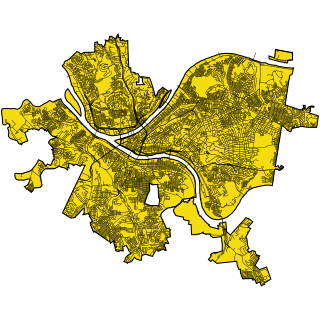Source:Harper
Frank C. Harper. Pittsburgh Day by Day. Pittsburgh Press, Jan. 4, 1929, p. 2. Newspapers.com 146332601.
STREET scenes in Pittsburgh have become more or less familiar not only to Pittsburghers themselves, but to a multitude in other cities and countries, who have seen pictures of our great mills and furnaces pouring flame (and smoke—yes, a little smoke) from their forests of smoke stacks.
But while our street scenes—the scenes of a great, prosperous manufacturing center—have lost the tang of novelty, our street names are an unopened book to most of us.
Even though automobiles have taken us out of the narrow beaten paths we formerly followed from day to day, going from our homes to our work and back from our work to our homes, street ignorance is widespread.
∗ ∗ ∗
WITH the above preface let me say I am indebted to John Ihlder, executive director of the Pittsburgh Housing Association, for an interesting letter on the subject of street names in Pittsburgh.
The association of which Mr. Ihlder is director is taking measures to improve the housing situation here, and so he just naturally gets about a great deal.
He has in fact got into so many out-of-the-way places that he has discovered some nooks and corners which a great majority of even the best-posted Pittsburghers have probably never heard of.
∗ ∗ ∗
THESE street names, Mr. Ihlder writes me, tell more vividly than a book of history the story of the city, giving "perhaps a little insight into the emotions of people long dead."
There may be a reason, he suggests, why Frock way and Wry way are so close together. Try st. probably commemorates a different endeavor, for it is on the other side of the river. But what is the history of Cuba-You-Quit way, and is there not left some of the spirit which led to the naming of Our way?
∗ ∗ ∗
TO THE downtown businessman Strawberry way and Resort way have probably become so familiar that they are simply names and nothing more.
But even he when taken to less familiar districts may feel that Peach way, Pasture st., Mulberry way, Blossom way, Verdant way, and Buttercup way require some explanation. For there is no buttercup now on Buttercup way and Verdant way long ago ceased to be verdant.
These names tell of another Pittsburgh just as do Tomahawk way, Boone st., Sachem st., Gen. Robinson st. and Dinwiddie st.
Our interests now are not in Indian massacres, pioneers, or colonial governors. Perhaps they ware not as keen as they once were in the things indicated by Protectory pl. and Epiphany st.
Manilla st., Siam st., Tripoli st. leave one guessing, but anybody can understand the impulse that led to naming streets for Emily, Jane, Sarah, Ophelia, Louisa, Flossie, Virginia and Augusta, though it does seem a little unfair that only Sidney and John among all the boys of Pittsburgh have been remembered.
∗ ∗ ∗
THIS conferring of street names, concludes Mr. Ihlder, seems to be largely an emotional matter (except when done by efficiency engineers) who actually had little to do with the original Pittsburgh street layout.
"We can be glad of the emotional factor, though," the interesting letter concludes, "even though the emption that gave us Progress street has not been at all times fully gratified and although the emotion that gave us Slush street has, we hope, lost its cause for being."
∗ ∗ ∗
ONE OF THE best-known physicians in Allegheny county is responsible for the following:
"A very common type of case at present is that of a patient who is slightly ill for two days and then feels well, with normal temperature, for two days. During these two days he is likely to get up and leave the house even though perhaps his physician's orders forbid him. Then on the fifth day he comes down with an illness much more severe than the original—usually a pneumonia.
"The presumption that it was disobedience to orders that caused the sequel is so strong that the physician is automatically alibied.
"Unfortunately these are not the only cases in which the dangerous sequel develops. It sometimes comes even where the physician's orders that the patient shall stay in bed through three days of normal temperature have been scrupulously followed.
"But even so, the outcome is much less liable to be very grave where the precaution of three days in bed after the recovery of normal temperature has been taken. Physicians as well as public cannot be too emphatically warned of the importance, in fact the downright necessity, of the full three-day precaution, even in the mildest flu cases."